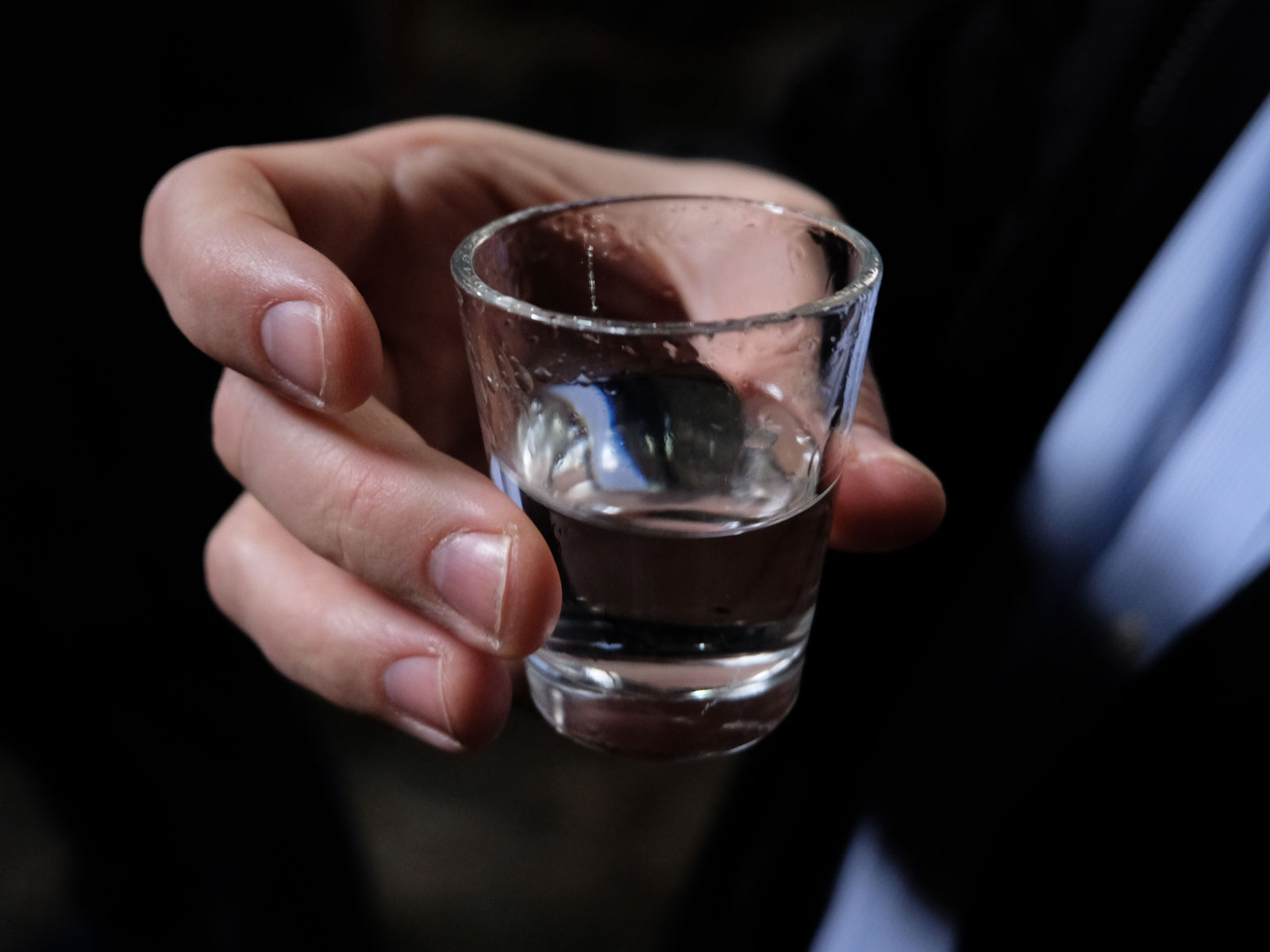Whether you’re into natural wine, sour beer, or funky Jamaican rum, baijiu is basically lightning in a bottle, and unlike anything else in the world.
If there’s one stop that stands out along Jordan Porter’s top-rated Chengdu Classics tour—aside from a heavily spiced, and deeply savory, heap of shredded, barbecued rabbit—it’s the alley that’s full of the longtime expat’s favorite pungent and pickled foods, including peanuts, mustard greens, garlic, radishes, and a fermented tofu that strikes fear in the hearts of most Westerners. Even more novel in the flavor profile department is a nearby stall that specializes in paojiu, a DIY form of infused baijiu. For those who are unfamiliar, baijiu is a vast category of clear yet complex spirits that’s played a prominent role in China’s drinking culture since the Ming Dynasty. Fermented sorghum is often the root of its secret recipes, although other grains—including rice, wheat, corn, and millet—pop up in proprietary blends throughout the country.
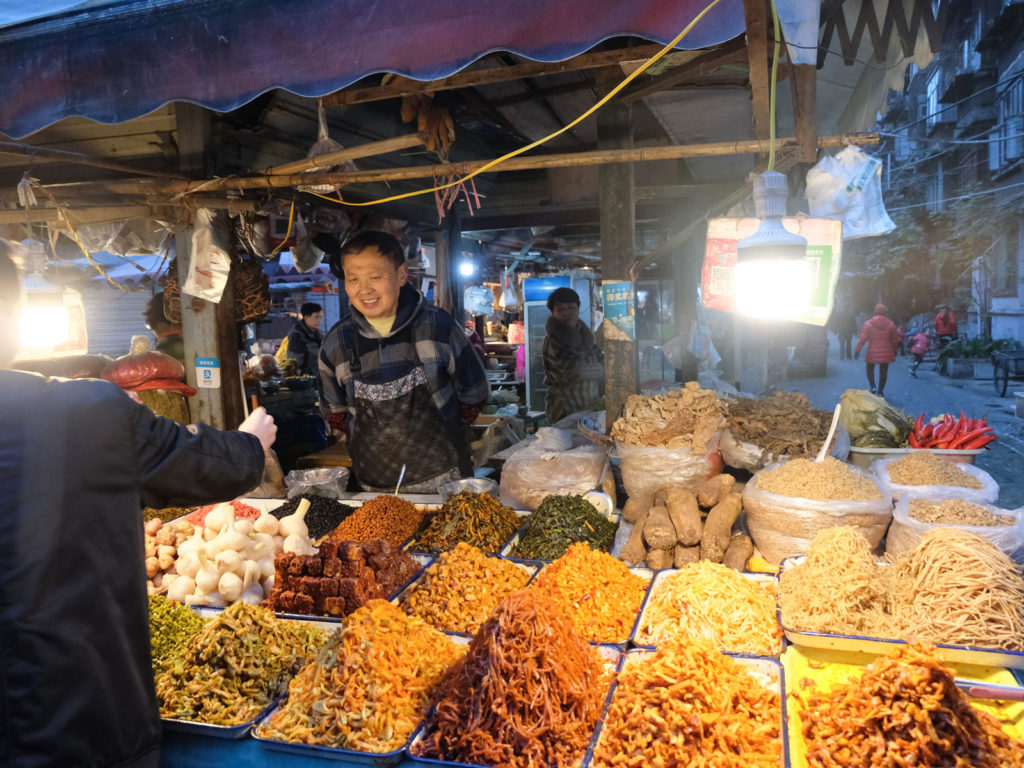
Due to its distinct smell, baijiu is categorized by its bouquet; strong, light, sauce (as in soy) and rice aromas make up most of the market. Paojiu softens the Sichuan province‘s steady diet of strong aroma baijiu with sugar and fruit (sour plums, cherries, persimmons), medicinal herbs (ginseng, cinnamon, ginger), or more beastly additives, like ants, snakes, and animal penises. Aside from making baijiu more palatable—they often cut ABV percentages down to the level of a strong wine—these infusions often have bigger health benefits in mind, from balancing one’s chi to aiding digestion after a marathon meal. Think of it as a tincture that gets you twisted, but everyone’s writing their own prescription.
“The thing about paojiu is it isn’t dominated by brands,” explains Porter, who also runs a local Baijiu Club with his business partner, Chengdu native Anita Lai. “Its glory is in its myriad homemade forms. Restaurants and families all do their own styles and it changes a lot regionally. I love to just explore what different places use, and how that ties to the geography and agriculture of a place.”

This inherent sense of terroir is what makes China—the Sichuan province especially, due to its fertile agriculture and high levels of humidity—such a thrilling place for adventurous drinkers. Whether you’re into natural wine, sour beer, or funky Jamaican rum, baijiu is basically lightning in a bottle, and unlike anything else in the world. Outside of what is commonly called erguotou—which includes popular, inexpensive brands like Red Star and Niulanshan—baijiu is not the ‘Chinese Everclear’ far too many foreign press features have made it out to be. In fact, it’s quite the opposite: the epitome of liquor that’s truly alive and eludes any easy descriptors.
“Baijiu has an undeserved reputation among non-Chinese drinkers,” says New York bartender Justin Lane Briggs. “That reputation certainly has some of its roots in ignorance and fear of the unknown, which is a real problem (and arguably linked to racism). Thankfully, I think people are starting to investigate some of their assumptions about ‘other’ places. Mainstream America has become more and more comfortable with broadening their palates, and with that, there has been a huge emphasis on food and drink that reflect a place, a people, a culture.”
A similar line of reasoning could explain the meteoric rise in the Stateside popularity of mezcal in recent years—while it once occupied the domain of a very particular palate, it’s now something everyday customers expect on left-field drink lists and major cocktail menus. Baijiu has a similar appeal: it’s a spirit that tells a story—and evokes an environment.
“Sichuan is a hotbed for bacteria,” explains Porter. “Whether you’re making paojiu or baijiu, it’s the same idea. There’s lots of stuff lying around, and if you can figure out how to harness it, you’ve got flavor. That’s the magic and mythology of baijiu, really: these simple [ingredients] produce a wonderful, unquantifiable array of flavors and aromas. It’s hard to articulate, really.”
One way to get a handle on how baijiu differs from other spirits is to see how it’s made firsthand. Most visitors do this by requesting an English-speaking guide at Shui Jing Fang. The only distillery located in the heart of Chengdu—most baijiu comes from rural and/or remote areas—it’s essentially a living museum, with spotless exhibition spaces in front and a closely monitored workspace out back.
Here’s the thing about Shui Jing Fang, however: It’s kind of like those commercials about John Jameson and the Captain Morgan. The brand’s only been around since 2000, but it’s been declared “the oldest distillery in China” because its parent company, Quanxing, stumbled upon the ruins of a 600-year-old facility when they were undergoing renovations in 1998. Since its mud pits—an old-school reservoir for fermenting grain—were still intact, along with its corresponding yeast cultures, the claim that it’s “had more than 600 years of continuous production” isn’t false so much as a convenient truth.
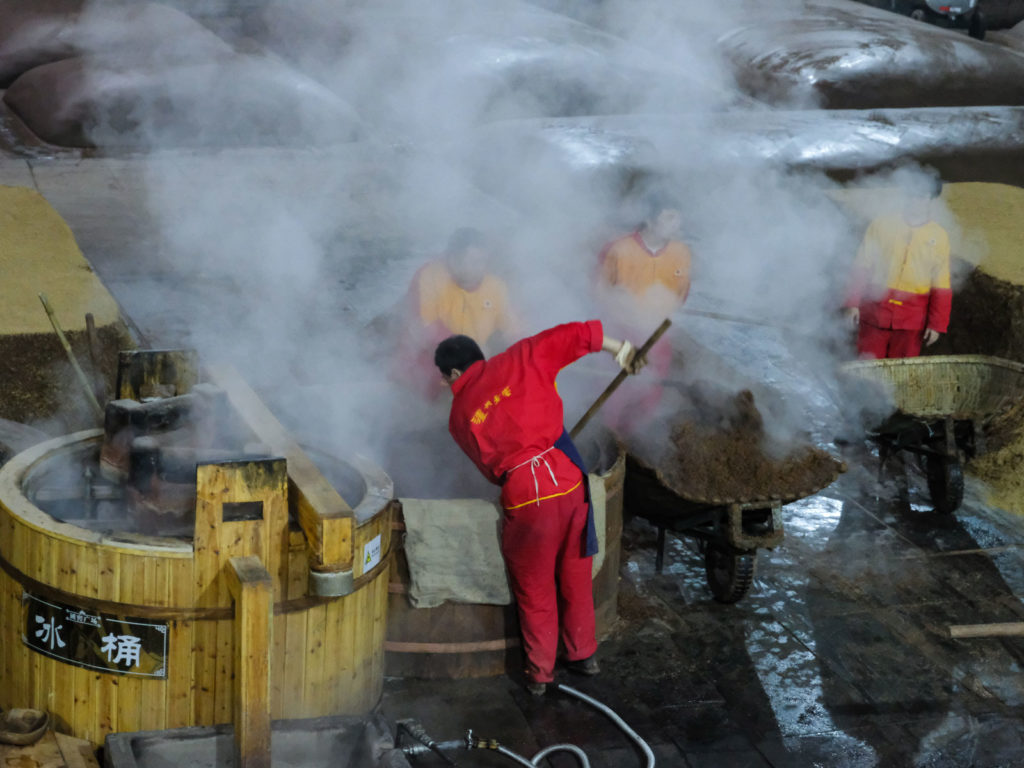
Striking a slightly less staged balance between mythmaking and mirth is Luzhou Laojiao, a state-run distillery located about three hours southeast of Chengdu. It’s one of the country’s top five brands, and the guides here let you linger over the production floor longer. Sure, everything is seen through a glass window, but the folks keeping LL’s beloved 1573 brand in circulation look far more laid-back and loose than the ones at Shui Jing Fang.
Our hosts at Luzhou Laojiao a few months back were the co-founders of Ming River, a new brand that’s distributed in the U.S. and Europe, but produced somewhere on the company’s secretive campus. During our walk through, we were able to watch Luzhou Laojiao’s signature “1,000-year pit, 10,000-year mash” process from start to finish. It begins with steaming locally-sourced sorghum. The grains are left out to cool, raked alongside previously distilled piles of sorghum, and sprinkled with qu, a unique blend of bacteria, yeast, and other naturally occurring microorganisms that converts starch to sugar and sugar to alcohol at the same time. Also known as solid-state fermentation, this procedure is only found in baijiu factories, and it’s what sends the spirit on its way to achieving spellbinding flavors.
A similar line of reasoning could explain the meteoric rise in the Stateside popularity of mezcal in recent years—while it once occupied the domain of a very particular palate, it’s now something everyday customers expect on left-field drink lists and major cocktail menus. Baijiu has a similar appeal: it’s a spirit that tells a story—and evokes an environment.
“They’re basically making a sorghum kimchi,” explains Derek Sandhaus, Ming River’s education director and the author of Baijiu: The Essential Guide to Chinese Spirits.
Once everything is properly mixed, the mash of fresh and spent grain is shoveled into sealed mud-lined pits—four of which date all the way back to 1573—and left to ferment for two to three months before undergoing distillation and the rest of baijiu’s production routine.
“They form a symbiotic relationship,” explains Sandhaus. “The pit itself starts participating in the fermentation process, as it absorbs more yeast and microbes from the mash. With pits this old, you can achieve flavor combinations you can’t get anywhere else really, because there’s nothing else as old as these pits.”
He pauses, smiles, and adds, “I hope that wasn’t too confusing.”

That’s the thing about baijiu, though; since there are so many ways to go from a mound of inoculated grain to a bottle of bold liquor, it can be confusing. Especially once you start drinking it. When we visited the GuShu distillery in Qionglai—a mountainous region west of Chengdu known for white-label baijiu (raw distillates sold to other factories for blending)—we weren’t struck by the centuries-old science of distillation. Aside from such modern innovations as cranes and cooling fans, and an enormous facility that felt like the world’s yeastiest airplane hangar, GuShu was following the same fermentation steps as Shui Jing Fang and Luzhou Laojiao. The main difference was its business plan: as one piece in a major pie of baijiu conglomerates.
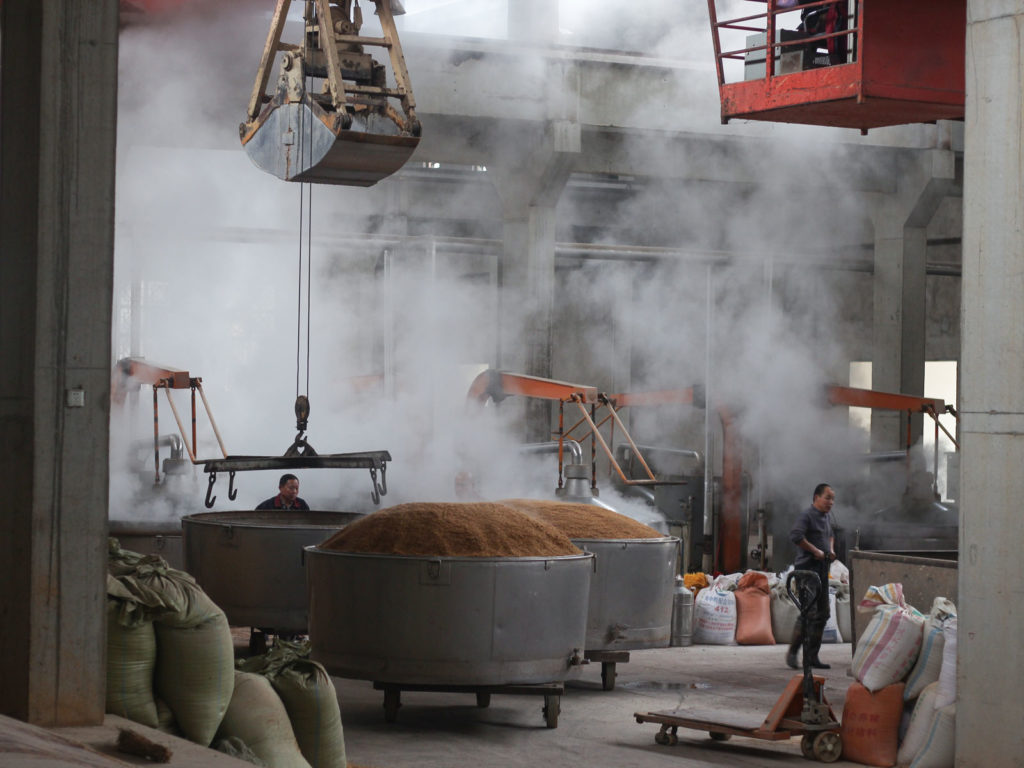
Where things got interesting with GuShu was our lazy susan lunch with its sorghum buyer. A native of Harbin, he used to watch people drink from noon to night to stay warm in the aptly named “Ice City” (it’s right near the Russian border). For people in Harbin back then—and the rest of China, for that matter—baijiu wasn’t a status symbol or subtle form of bribery so much as something you shared with loved ones.
At one point in our conversation, the buyer starts talking in proverbs, many of which relate back to the beloved Chinese poet Li Bai. They’re phrases that frame drinking as a form of creative inspiration—things like “drink more, feel more”, or “drink to feel up, not down”. More importantly, our translator, Ryan Gage Friesen, a Canadian who is one of Porter’s oldest employees, explains, is how baijiu can bring people closer together. “‘When you drink with people you don’t really know, a little bit [of baijiu] seems like a lot,'” he says, “‘but when you’re with your friends, one thousand cups isn’t enough.’ That’s the drinking culture in China in essence.”
The problem for baijiu companies is how that culture became co-opted by Western drink trends over the past couple decades, with younger Chinese people turning towards craft beer, cocktails, and other spirits instead of the strong aroma shots they associated with old dudes and their grandparents. Folks like Luzhou Laojiao and Moutai—the world’s most valuable distiller—were fine with this at first, because they could rely on major business meetings and China’s gifting culture moving big money bottles every month.

Or as Sandhaus put it, “I was talking to this distiller once who sold a standard baijiu at $100 and the next step up at $3,000. I said, ‘It’s just you and me here; let’s be real. There can’t be a qualitative difference between what you’re selling for a hundred dollars and what you’re selling for three thousand.’ And he was like, ‘You don’t understand; when I price something at three thousand dollars, I get calls from customers who say it’s not expensive enough. Putting a three thousand dollar bottle on the table is saying this is how much I like you.'”
President Xi Jingping destroyed this dichotomy by enacting a crackdown on corruption about five years ago. The sudden move caused a downward spike in sales and forced established brands to finally go after two groups they’d long ignored: women and millennials. One person who’s helped with this transition is Yuchen Zhong, the co-founder of the baijiu education firm Yuan Kun. A Chengdu native, he studied management information systems at Ohio State and worked at a software company in Shenzhen and Beijing before deciding to move back home and focus on consulting baijiu companies.
“Baijiu is a huge industry,” he explains, “but in many ways, it’s still a young one. Most distilleries don’t know how to build or manage a modern company, and they have no idea what wine, sake, or whiskey brands are doing.”
That’s starting to change, however. “Distilleries have been shifting the palate of their products in recent years,” Zhong says, “towards a lighter flavor and body, and a lower ABV. They also started developing sub-brands that employ more fashionable designs. Even traditional baijiu is trying to look prettier. The question is what happens when millennials become the center of society? Will they still accept baijiu, a drink that is heavily associated with unpleasant business dinners?”
Capital Spirits was one of the first bars to do this in Beijing, offering flights to foreigners who wanted to drink baijiu straight and well-balanced cocktails to Chinese customers looking for a fresh take on an old-fashioned spirit. Two high-end hotels in Chengdu now offer baijiu cocktails at their bars as well: Cube at the Fairmont and Jing at The Temple House. We tried the latter recently, and discovered two new drinks bar manager Layla Wang is developing for the Chinese New Year. While one was a dark and brooding take on a Manhattan, the other was fruity and floral, with a tinge of sweetness and a creamy strawberry finish. When we pointed out how easy it was to drink without masking the baijiu, she laughed and smiled, saying, “I’m not hiding it; it’s called balance.”
A similar approach has taken hold in the U.S. over the past year, as emerging stateside brands like Ming River and Ganbei join Portland’s nearly decade-old Vinn distillery in pursuit of the country’s most open-minded consumers.
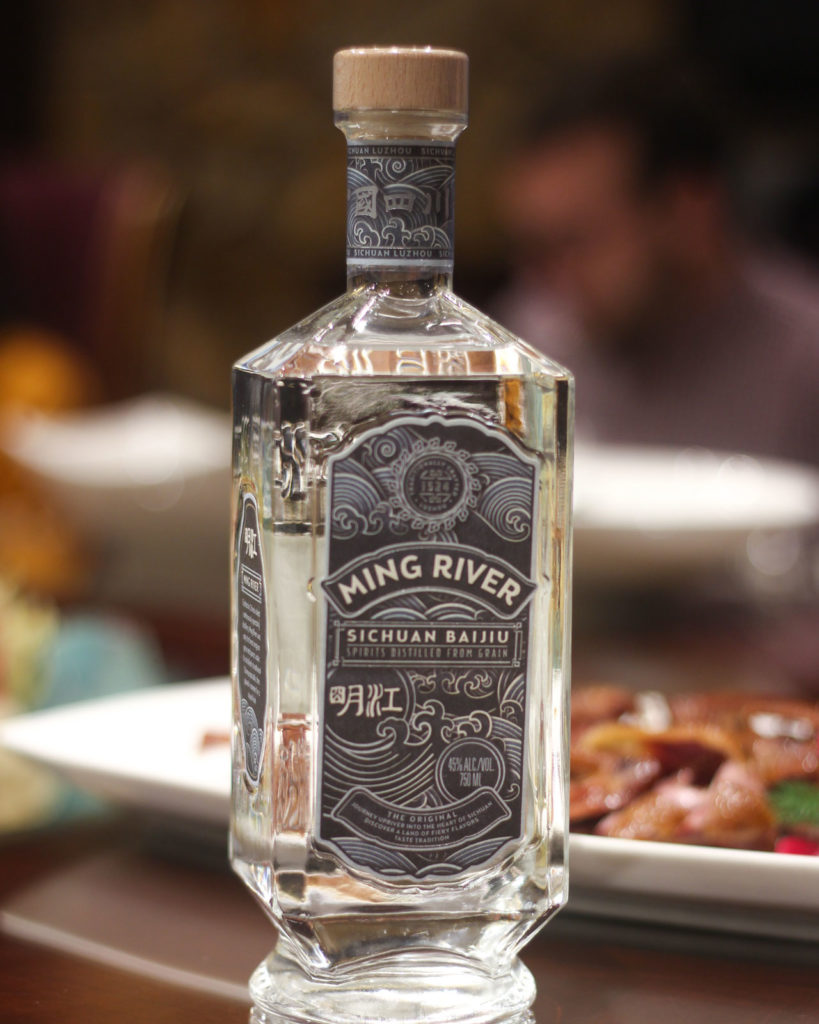
“When we first started, it was a foreign thought to put baijiu in a cocktail because that was never done in our household,” says Vinn president Michelle Ly. “But we were fortunate enough to meet a creative mixologist (Botanist Bar PDXowner Robbie Wilson) that had a strong understanding of how to mix rice spirits in a cocktail. That was an eye opener, for sure. His cocktails didn’t hide the flavor of our baijiu; it showcased it.”
Vinn’s rice aroma baijiu is based on a family recipe that’s seven generations old and reflects their roots in both China and the Quang Ninh Province of North Vietnam. It holds the distinction of being the only Chinese spirit distilled within our borders, forsaking pit fermentation and steamer baskets for brewer buckets, pot stills, and a scratch-made qu that revolves around rice flour and a hush-hush mixture of herbs and spices.
Ganbei’s founders, Andrew Hoogerwerf, Alec Fotsch, and Kockyo Xiong, launched their strong aroma baijiu in the Twin Cities at the tail end of 2018 after nearly two years of product development and searching for a distiller that could toe the line between accessibility and tradition. They eventually found the latter in the autonomous Chinese region of Inner Mongolia; led by a master blender named Hetao, Ganbei’s production team honed its recipe down to a “full-bodied, fruit-forward spirit with subtle, earthy tones, notes of stone fruit, anise and elderflower, and a crisp, light finish.”
“Most people who have tasted our product love it,” says Hoogerwerf. “Especially in cocktails. One of my favorite things to do is bring it to a bartender at his/her location. I can see the creativity flash in their eyes; it is as if a painter just discovered an entirely new color, opening up flavor possibilities that simply weren’t there before.”
Matthew Voss, the head bartender at Marvel Bar in downtown Minneapolis, was one early adopter, incorporating Ganbei in both a gimlet and a Manhattan. “It’s the first spirit in a long time that really made me question it,” he explains. “Like what is this and where does it belong?
He continues, “Everything that makes it a challenge is what makes it special, though. Maybe because of the saturation of upstart breweries and distilleries—many of which are putting out similar things—people will start looking for something new. And they can be led to baijiu. It’s one of my favorite things to put in front of people because it’s a button-pusher. People have strong opinions for and against it, but a lot of the people who love flavor in particular are really challenged by it. That’s not something we get to experience much anymore.”

